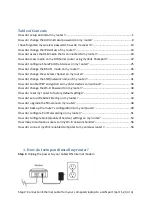
Billion 810VGTX Router
Page | 97
Echo Cancellation: G.168 echo canceller is an ITU-T standard. It is used to isolate the echo while you are on the
phone. This helps you not hear your own voice on the phone while you talk. Default is set to ‘Enable’.
RTP Port: Provides the base value from the media (RTP) ports that are assigned for various endpoints and the
different call sessions that may exist within an end-point. (Range from 5100 to 65535, default value is 5100)
Region: This selection is a drop-down box, which allows a user to select the country in which the VoIP device is
active. When a country is selected, the country parameters are automatically loaded.
Voice QoS, DSCP Marking: Differentiated Services Code Point (DSCP), it is the first 6 bits in the ToS byte. DSCP
Marking allows users to assign specific application traffic to be executed in priority by the next Router based on the
DSCP value. See Table 4. The DSCP Mapping Table:
Note: Be sure that the router(s) in the backbone network have the ability to execute and check the DSCP
markings through-out the QoS network.
Advanced – Parameters
VoIP through IP Interface: IP Interface decides where to send/receive the VoIP traffic; it includes: ipwan and iplan.
Easy way to select the interface is to check the location of the SIP server. If it is located somewhere on the Internet
then select ipwan. If the VoIP SIP server is on the local Network then select iplan.
Voice Frame Size: Frame size is available from 10ms to 60ms. Frame size meaning how many milliseconds the
Voice packets will be queued and sent out. It is ideal to have the same frame size on both Caller and Receiver.
Dial Plan Priority: Define the priority between VoIP and PSTN dial plan.
PSTN Auto-fallback: Whenever VoIP SIP responds with an error or an error code matching the codes in the Edit
section, the VoIP calls will automatically fallback to PSTN. In other words, the call will be made via the PSTN when
VoIP SIP returns an error code.
Click ‘Edit’ to add or remove response codes. Be sure that the codes are separated by a comma (,).
For more information about SIP response codes, please go to this link
http://voip-info.
org/wiki/view/sip+rcodes
. You will get the meaning of all the SIP responses here.
T.38 Fax Relay: It allows the transfer of facsimile documents in real-time between two standard Group 3 facsimile
terminals over the Internet or other networks using IP protocols. It will only function when both sites support this
feature and have it enabled.
















































